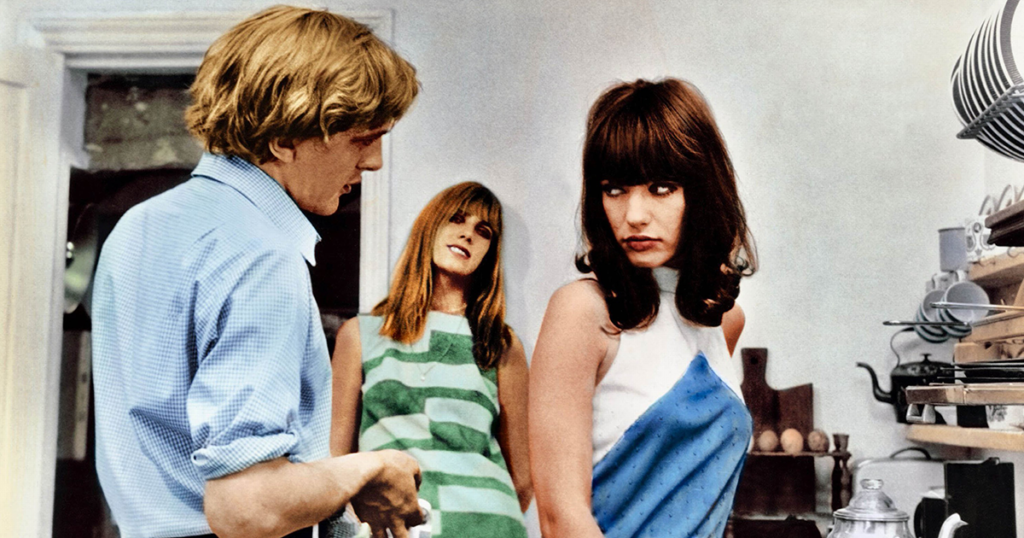The Allure of the Enigmatic
“Mod” London takes center stage in Michelangelo Antonioni’s mind-blowing Blow-Up

When it was released in 1966, Michelangelo Antonioni’s Blow-Up blew the minds of student cineastes and literary intellectuals at Columbia University—including me. Having just entered the college as a freshman, I sat at the feet of the elders at The Columbia Review and King’s Crown Essays and took a crash course in cinema as an art form.
In avant-garde circles in general, there was a cult around such European directors as Antonioni, Ingmar Bergman, Luis Buñuel, Federico Fellini, Jean-Luc Godard, François Truffaut, and Agnès Varda. Antonioni’s Italian-language movies—L’Avventura (1960), La Notte (1961), and L’Eclisse (1962)— offered an attractive blend of enigma, ennui, eros, existential fatigue, and Monica Vitti.
L’Avventura has a beginning and middle, but no true end. The character played by Lea Massari disappears; her disaffected lover (Gabriele Ferzetti) and best friend (Vitti) try to find her, and the film arrives at no resolution. It would be as if, having done away with his heroine 45 minutes into Psycho, Hitchcock failed to provide an explanation and a compensatory story to make up for her absence. The ambiguity in L’Avventura goes up a notch in Blow Up.
Antonioni based Blow-Up, his first English-language feature, on a story by the Argentine novelist Julio Cortázar. He set the film in London, “mod” headquarters in the heyday of the Beatles, Carnaby Street, and psychedelic nightclubs. David Hemmings plays Thomas, a nervy fashion photographer with artistic instincts. Besides taking pictures of professional models who resemble heavily made-up mannequins, he spends his time fending off wannabe models, visiting an antiques dealer, and going to pubs and clubs.
There’s a very hot scene featuring Jane Birkin and Gillian Hills trying on clothes and playing sex games with the photographer. In an American movie, such scenes would have a bearing on the plot. Here they are all red herrings, though they do contribute to the movie’s powerful atmospheric effects.
When Thomas ducks out on a photo session, he takes his camera with him to a park. There, in an otherwise unpeopled patch of meadow, he clicks away at a man and a woman in a clandestine embrace. When Jane (Vanessa Redgrave), the woman in the scene, becomes aware of what he is doing, she hurries over to confront him. She demands the roll of film. She even follows him back to his studio, evidently prepared to go to any length to recover the photos. After shaking Jane off by giving her a false roll, Thomas develops the film, makes enlargements, and lo, there is a gun in the bushes.
Is there also a corpse? Has Thomas inadvertently photographed a murder? What should he do about it? Hemmings hems and haws, which the soundtrack anticipates: The Lovin’ Spoonful’s “Did You Ever Have to Make Up Your Mind?” plays in the background earlier in the film.
There are elements of the classic murder mystery in Blow-Up. A dead body is there, and then it isn’t. The incriminating photos are there, and then, because the photographer’s studio with the incriminating enlargements has been ransacked, they’re gone. The effect is less a matter of suspense than of paranoia and perplexity. If the film has an allegorical dimension, it is that great shibboleth of the ’60s: “Nothing is real”—or, more exactly, nothing can stand the test of empirical existence unless it is recorded. To an extent, then, the movie is about movies, what we see versus what we think we see.
Besides the cunning ambiguity of the plot, I would single out two other elements that distinguish this major movie: Blow-Up offers a beguiling snapshot of the Zeitgeist, and it ends marvelously, with an unforgettable final sequence.
The spirit of London’s Swinging Sixties pervades the movie. It is as if everyone is high. In a club, the Yardbirds—a popular band, with Jeff Beck on guitar—perform their song “Stroll On.” When Beck smashes his guitar on stage and throws the neck of the instrument into the crowd, a frenzied fight for the souvenir ensues. Thomas gets into the thick of it and emerges triumphant. Leaving the club with his trophy, he soon throws it away. And when a passerby picks it up, looks it over, and discards it, the parable on what constitutes value is complete.
At a party for which jazz pianist Herbie Hancock provides the score, Thomas encounters the beautiful German model Verushka. “I thought you were supposed to be in Paris,” he says. “I am in Paris,” she replies, puffing on a joint. Before the evening is over, Thomas will take LSD with his agent, Ron. At dawn he returns to the park, expecting to find the corpse he saw earlier, only it is no longer there.
Going home, Thomas comes across mimes at a tennis court, playing with invisible balls and rackets. They gesture to show that their ball is lost and ask Thomas to retrieve it. He does as instructed, miming the action, and then the camera pulls back, Thomas vanishes, and the inevitable murmur from the audience tells us that we have seen something extraordinary, the allure of the enigmatic.


